On June 29th LONGi launched its new Hi-MO 5 product for ultra large power plants. Hi-MO 5 is based on M10 gallium doped monocrystalline wafers and uses smart soldering technology. The 72c module power reaches 540W, with an efficiency of more than 21%. The product not only has excellent reliability on the manufacturing side, but also brings more value to customers on the system side. This article will explain how Hi-MO 5 performs so well on the BOS cost saving side and its underlying logic.
Scientific BOS analysis model
The calculation is based on the mainstream power of bifacial modules, with a 410W G1 module and a 495W G12 module compared with Hi-MO 5. It can be seen that Hi-MO 5 has obvious advantages both in power and efficiency.

The standard environmental conditions are set as follows: Flat terrain, extreme low temperature of -13°, high temperature of 40°, basic wind pressure 0.4kN/㎡, basic snow pressure 0.5kN/㎡;the tilt angle is 20°.
In equipment selection, a 3.125MW centralized inverter (1500V) is used, with the DC to AC ratio about 1.1 (the array capacity is 3.44MW), a 24 to 1 combining box is chosen; a fixed bracket with portrait mounting type (considering the fairness of calculation, 4 rows landscape mounting is not used).
Dig deep into key factors:single string power
In the development stage of Hi-MO 4, LONGi realized that single string power is the key factor for determining system BOS. Therefore, on the premise of product feasibility, the priority is to increase module current without changing module voltage, which will avoid the influence on the number of module strings.
According to 1500V system voltage and extreme low temperature, the number of strings can be determined. Compared with a G1 module, Hi-MO 5 can maintain the same number of strings. However, the number of single strings for a G12 module will be reduced by one piece. Therefore, the string power of Hi-MO 5 will be 30.5% higher than a G1 module and 12.1% higher than a G12 module.
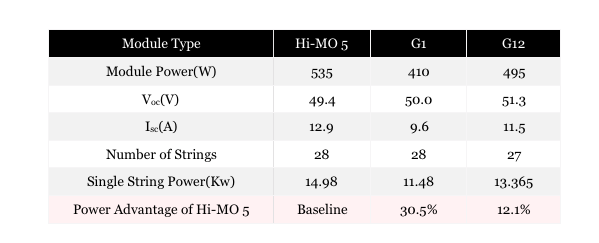
Saving the cost of brackets
For two rows of landscape brackets, one can support two strings of modules. The higher the single string power, the higher the module power on the bracket. The bracket can support higher power of modules by extending the rail – in this case the increase of steel consumption is less than the increase of single string power, thus the cost of bracket per watt will be reduced.
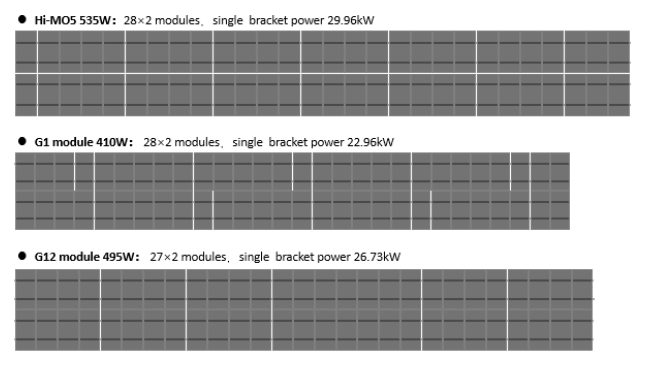
According to module weight and environmental snow and wind pressure, the bracket consumption can be calculated. For the same 3.44MW array, the total steel consumption of brackets for Hi-MO5 is 9.9% less than for a G1 module and 2.5% less than for a G12 module, which will also bring the same level of cost saving in brackets: the cost of brackets for Hi-MO5 is $0.37 cents/W less than for a G1 module and $0.08 cents/W less than for a G12.
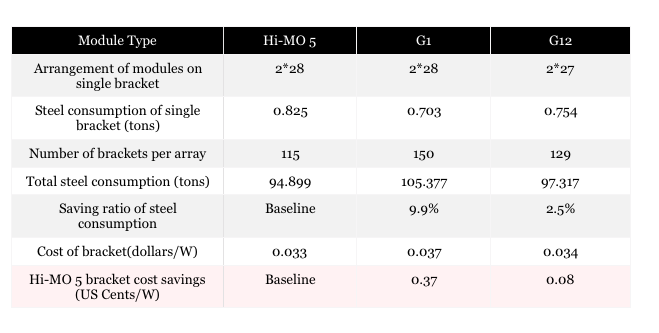
Saving on cost of pile foundation
According to the mechanical loading and environmental conditions, the steel consumption of brackets and number of pile foundations can be determined. In this design scenario, the number of pile foundations for a Hi-MO 5 is one more than that for a G12, but with total brackets reduced, the total pile foundation will also be reduced. The cost of Hi-MO 5 is $ 0.35 cents/W less than that of a G1 module and $ 0.27 cents/W less than that of a G12.
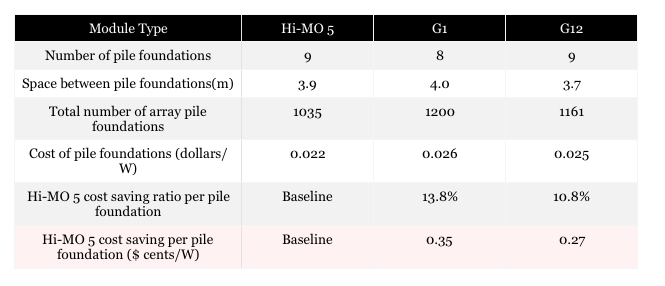
Saving on land cost
The PV array can be formed by arranging brackets according to the array space, thus calculating the area of the array. On the one hand, the efficiency improvement of Hi-MO 5 will reduce the total coverage area of module and array gap; On the other, the increase of single string power will reduce the number of brackets and the area of bracket gap. It can be seen in the following table that the land cost of Hi-MO 5 is 4.6% less than that of a G1 module and 2.1% less than that of a G12. The detailed cost savings will depend on fees for land occupation, rent and usage. In this case, an annual rent fee of 35 dollars per mu is used for calculation.
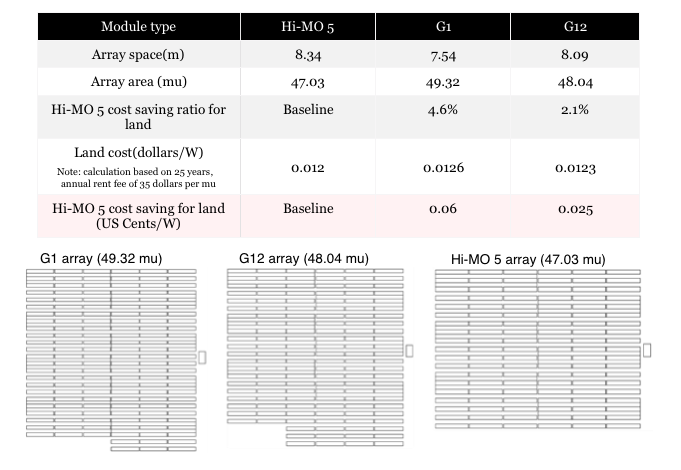
Saving on cable and combiner box costs
The combiner box is used for bringing 24 string modules together, the increase of single string power reducing the number of combiner boxes. The cable is used to connect each string to the combiner box, with DC cable used to connect the combiner box and inverter. Due to the decrease in module strings, combiner boxes and array area, the cable consumption and installation costs for the Hi-MO 5 will be reduced significantly. In this case, the cost of a Hi-MO 5 is $0.476 cents/W less than that of a G1 module and $0.115 cents/W less than that of a G12.
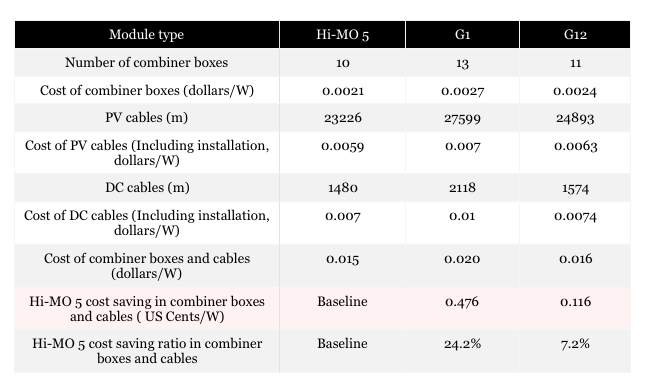
Saving on manual installation costs
With the same array capacity, the number of modules and bracket weight will be reduced by choosing Hi-MO 5. Based on 2.1 dollars/piece for module installation and 211.3 dollars/ton for bracket installation, the total installation cost for Hi-MO 5 is 0.186 US cents/W less than that for a G1 module and 0.046 US cents/W less than that for a G12.
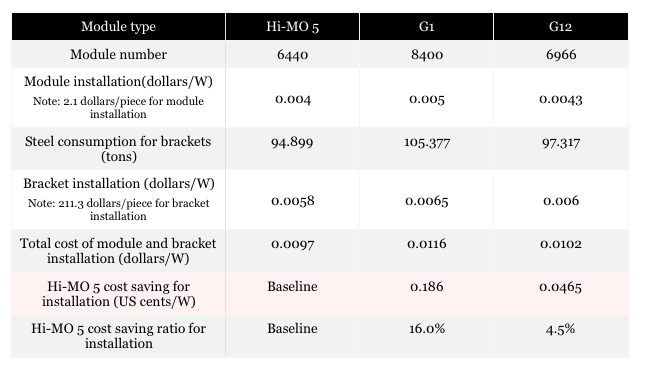
Considering all these factors (brackets, pile foundations, cables, combiner boxes, installation and land cost), the BOS of a Hi-MO 5 is 1.44 US cents/W less than that of a G1 module and 0.535 US cents/W less than that of a G12.
Summary
In this article, under the premise of setting standard environmental conditions, the BOS cost saving for a Hi-MO 5 compared with G1 and G12 modules is calculated based on centralized and string inverters. It is proven that Hi-MO 5 is the product with the lowest LCOE for ultra-large power plants. If using a tracker system, the Hi-MO 5 will save more in tracker costs. Additionally, when using a string inverter, the Hi-MO 5 can significantly increase the DC to AC ratio, thus diluting the cost of all the equipment on the AC side and bringing more value to investors.

